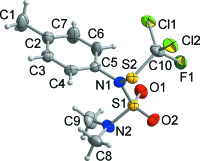Crystal structure of tolyl-fluanid
- PMID: 25484703
- PMCID: PMC4257202
- DOI: 10.1107/S1600536814020741
Crystal structure of tolyl-fluanid
Abstract
The title compound, C10H13Cl2FN2O2S2 {systematic name: N-[(di-chloro-fluoro-methyl)-sulfanyl]-N',N'-dimethyl-N-p-tolyl-sulfamide}, is a well known fungicide. The dihedral angle between the mean plane of the di-methyl-amino group and that of the benzene ring is 32.3 (3)°. One Cl atom and one F atom of the di-chloro-fluoro-methyl-thio group are disordered over two sets of sites with an occupancy ratio of 0.605 (9):0.395 (9). In the crystal structure, two C-H⋯Cl hydrogen bonds link adjacent mol-ecules, forming dimers with R 2 (2)(14) loops. C-H⋯O hydrogen bonds link pairs of dimers into chains along the b-axis direction. These chains are joined by an additional C-H⋯O contact, generating a sheet in the ab plane.
Keywords: crystal structure; fungicide; hydrogen bonds; tolylfluanid.
Figures


Similar articles
-
Crystal structure of difenoconazole.Acta Crystallogr Sect E Struct Rep Online. 2014 Oct 24;70(Pt 11):o1173. doi: 10.1107/S1600536814022429. eCollection 2014 Nov 1. Acta Crystallogr Sect E Struct Rep Online. 2014. PMID: 25484812 Free PMC article.
-
Crystal structures of three N-(aryl-sulfon-yl)-4-fluoro-benzamides.Acta Crystallogr E Crystallogr Commun. 2016 Mar 31;72(Pt 4):575-82. doi: 10.1107/S2056989016005089. eCollection 2016 Apr 1. Acta Crystallogr E Crystallogr Commun. 2016. PMID: 27375892 Free PMC article.
-
Crystal structure of flufenoxuron: a benzoyl-urea pesticide.Acta Crystallogr Sect E Struct Rep Online. 2014 Sep 17;70(Pt 10):o1110. doi: 10.1107/S1600536814020649. eCollection 2014 Oct 1. Acta Crystallogr Sect E Struct Rep Online. 2014. PMID: 25484700 Free PMC article.
-
Crystal structure of dimethyl 3,3'-[(4-fluoro-phen-yl)methyl-ene]bis-(1H-indole-2-carboxyl-ate).Acta Crystallogr E Crystallogr Commun. 2015 Sep 12;71(Pt 10):1140-2. doi: 10.1107/S205698901501628X. eCollection 2015 Oct 1. Acta Crystallogr E Crystallogr Commun. 2015. PMID: 26594391 Free PMC article.
-
Crystal structures of two 2,9-di-thia-13-aza-dispiro-[4.1.4(7).3(5)]tetra-decan-6-ones.Acta Crystallogr E Crystallogr Commun. 2015 Nov 21;71(Pt 12):1516-20. doi: 10.1107/S2056989015020885. eCollection 2015 Dec 1. Acta Crystallogr E Crystallogr Commun. 2015. PMID: 26870418 Free PMC article.
References
-
- Brandenburg, K. (2010). DIAMOND Crystal Impact GbR, Bonn, Germany.
-
- Bruker (2009). APEX2, SAINT and SADABS Bruker AXS Inc., Madison, Wisconsin, USA.
-
- Ogata, M., Matsumoto, H., Shimizu, S., Kida, S., Wada, T., Shiro, M. & Sato, K. (1986). J. Med. Chem. 29, 417–423. - PubMed
-
- Sheldrick, G. M. (2008). Acta Cryst. A64, 112–122. - PubMed
LinkOut - more resources
Full Text Sources
Other Literature Sources
